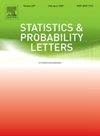A principal mixed-order moments method for CKMS in dimension reduction
IF 0.7
4区 数学
Q3 STATISTICS & PROBABILITY
引用次数: 0
Abstract
This paper presents a new Sufficient Dimension Reduction (SDR) approach, termed the Principal Mixed-order Moments (PMoM) method, for estimating the central th moment subspace (CKMS). We develop a computational algorithm to implement PMoM and establish its consistency properties. To evaluate its effectiveness and efficiency, we conduct Monte Carlo simulations. Notably, PMoM demonstrates strong performance, especially in cases where the variance of individual components varies significantly, particularly under an elliptical distribution of predictor variables. Real data analysis in the Energy Efficiency dataset confirms the effectiveness of PMoM, highlighting its practicality in high-dimensional data reduction.
CKMS降维的一种主要混合阶矩法
本文提出了一种新的充分降维方法——主混合阶矩法,用于估计中心第k阶矩子空间(CKMS)。我们开发了一种计算算法来实现PMoM,并建立了它的一致性。为了评估其有效性和效率,我们进行了蒙特卡洛模拟。值得注意的是,PMoM表现出很强的性能,特别是在个别成分的方差变化很大的情况下,特别是在预测变量的椭圆分布下。能源效率数据集的实际数据分析证实了PMoM的有效性,突出了其在高维数据约简中的实用性。
本文章由计算机程序翻译,如有差异,请以英文原文为准。
求助全文
约1分钟内获得全文
求助全文
来源期刊

Statistics & Probability Letters
数学-统计学与概率论
CiteScore
1.60
自引率
0.00%
发文量
173
审稿时长
6 months
期刊介绍:
Statistics & Probability Letters adopts a novel and highly innovative approach to the publication of research findings in statistics and probability. It features concise articles, rapid publication and broad coverage of the statistics and probability literature.
Statistics & Probability Letters is a refereed journal. Articles will be limited to six journal pages (13 double-space typed pages) including references and figures. Apart from the six-page limitation, originality, quality and clarity will be the criteria for choosing the material to be published in Statistics & Probability Letters. Every attempt will be made to provide the first review of a submitted manuscript within three months of submission.
The proliferation of literature and long publication delays have made it difficult for researchers and practitioners to keep up with new developments outside of, or even within, their specialization. The aim of Statistics & Probability Letters is to help to alleviate this problem. Concise communications (letters) allow readers to quickly and easily digest large amounts of material and to stay up-to-date with developments in all areas of statistics and probability.
The mainstream of Letters will focus on new statistical methods, theoretical results, and innovative applications of statistics and probability to other scientific disciplines. Key results and central ideas must be presented in a clear and concise manner. These results may be part of a larger study that the author will submit at a later time as a full length paper to SPL or to another journal. Theory and methodology may be published with proofs omitted, or only sketched, but only if sufficient support material is provided so that the findings can be verified. Empirical and computational results that are of significant value will be published.
 求助内容:
求助内容: 应助结果提醒方式:
应助结果提醒方式:


